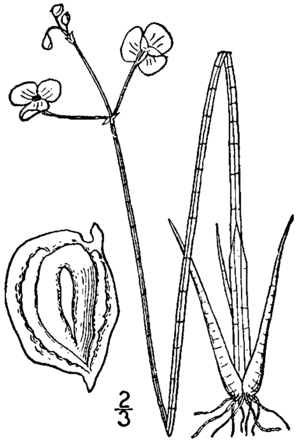Quill-leaved arrowhead facts for kids
Quick facts for kids Quill-leaved arrowhead |
|
|---|---|
 |
|
| Scientific classification | |
| Genus: |
Sagittaria
|
| Species: |
teres
|
| Synonyms | |
|
Sagittaria graminea var. teres (S.Watson) Bogin |
|
Sagittaria teres, also known as the quill-leaved arrowhead or slender arrowhead, is a special kind of plant that loves water. It is an aquatic plant, which means it grows in or near water. You can find this plant naturally in the northeastern United States. This includes states like Rhode Island (in Providence and Washington Counties), Massachusetts, New Hampshire (in Hillsborough County), New York (especially Suffolk County), and New Jersey.
This plant likes to grow by the edges of lakes, in marshy areas, and other wet places. It often prefers water that is a bit acidic, like the kind found in Sphagnum bogs.
Sagittaria teres is a perennial herb. This means it's a plant that lives for more than two years and doesn't have a woody stem. It can grow quite tall, up to 80 centimeters (about 32 inches). Its leaves are interesting because they can grow both underwater and above the surface. The plant produces pretty white flowers. Each flower is about 1.5 centimeters (0.6 inches) wide. These flowers grow in groups called whorls along a stalk that rises above the leaves.
Contents
Where it Grows and What it Looks Like
Sagittaria teres is a unique plant that thrives in specific watery environments. It's often found in places where the water is a bit acidic. Think of areas like Sphagnum bogs, which are wetlands with special mosses that make the water slightly sour.
Plant Features
This plant is known for its slender, quill-like leaves. These leaves can adapt to their surroundings. Some leaves stay underwater, while others grow up into the air. This helps the plant get sunlight and nutrients from both places. The flowers are small and white. They grow in circles around the main stem, which is what a "whorl" means in botany. This arrangement makes the plant look quite elegant when it's in bloom.
Conservation Status in the United States
Because Sagittaria teres needs specific conditions to grow, it's not found everywhere. In some places, its numbers are getting very low. This means it needs protection.
Why it Needs Protection
- Endangered: This plant is listed as endangered in several states. This means there are very few of them left in the wild in Connecticut, New Jersey, New York, and Rhode Island. Being endangered means they are at high risk of disappearing forever if we don't protect them.
- Special Concern: In Massachusetts, Sagittaria teres is listed as a "special concern" species. This means it's not yet endangered, but its population is declining, and scientists are worried about its future. It needs careful watching to make sure it doesn't become endangered.
Protecting plants like Sagittaria teres helps keep our natural wetlands healthy and full of different kinds of life.

